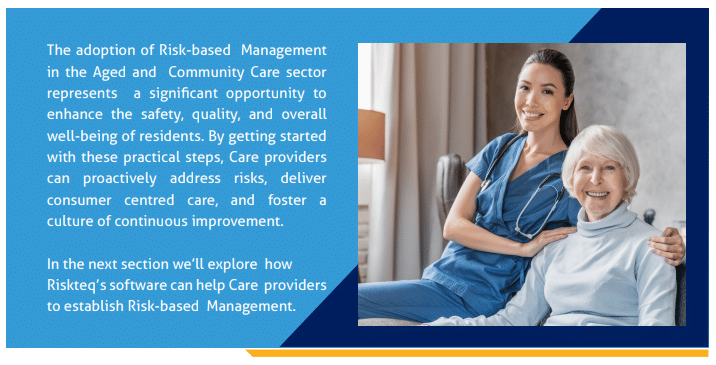
Implementing a Risk-based management approach in Aged and Community Care requires a systematic, comprehensive and ongoing process. It has to be culturally embedded and become part of “the way we do things around here”.
Here are 10 practical steps that can help Care providers get started:
- Demonstrate senior leadership commitment
Strong support from organisational leadership is essential to foster a risk-aware culture and ensure adequate resources for risk management activities. - Establish a cross functional dream team to own risk management
Form a dedicated team of highly respected top achievers that can be responsible for defining, implementing and overseeing your risk management activities. This team should include representatives from various departments, such as clinical care, administration, quality assurance and compliance. It is crucial to go beyond managers and include influential individuals from frontline roles so that this is viewed as a collective organisational wide initiative, not simply another management mandate. Ensuring a strong frontline voice is represented in your risk team is a prerequisite if the change is to be culturally embedded and driven. - Enable your risk team with the right technology and tools
Consider using integrated risk management software to assist with robust data collection, risk analysis, feedback management and facilitate evidence based decision making. - Conduct comprehensive risk assessments
Identify and document potential risks across all aspects of your operations. This should encompass areas like regulations, compliance, resident care, staff training, infection control, medication management, and more. Ensure your risk assessment efforts are tailored to individual resident needs and preferences. Recognize that each resident is unique and may have specific risks or concerns that require attention.
- Link risks to business objectives
Track each risk back to the business objectives that they impact to ensure all stakeholders have clear visibility of how risk management activities impact business goals. Establish key performance indicators to measure and track effectiveness.
- Prioritise risks and develop mitigation plans
Evaluate risks based on their impact and likelihood of occurrence. Ensure each risk is linked to a mitigation plan that is specific and actionable. Individual (internal and contractor) owners, workflows and dependencies should be clearly mapped.
- Document procedures
Document risk management procedures, including how risks are assessed, prioritised, and mitigated. This documentation ensures consistency and provides a reference for staff.
- Encourage and train staff
Train staff on their roles in identifying, mitigating and managing risks. Ensure that staff are aware of and have digital access to appropriate procedures, policies and expectations. Encourage and train staff to actively participate in the risk management process by seeking their input, ideas, and feedback.
- Drive communication and reporting
Establish clear digital communication channels for reporting risks and incidents. Encourage and make it as easy as possible for staff, residents, and families to report potential risks or concerns.
- Monitor and improve
Regularly review incidents, near-misses, and feedback from staff, residents and families to identify areas for improvement. Use the insights gained to refine risk management strategies and adapt to changing circumstances. This will cultivate a culture of continuous improvement.

Riskteq Software for Risk-based Management
Riskteq software enables Care providers to embed a Risk-based Management culture by providing the digital infrastructure for comprehensive risk identification, analysis, mitigation, monitoring, review, communication and collaboration.
Comprehensive Risk Assessments
Riskteq software facilitates comprehensive risk assessments with standardised templates tailored to the specific needs of Aged and Community Care. This ensures that critical risk factors are not overlooked and that all aspects of care, from resident safety and well-being to facility management, are thoroughly analysed to support informed decision making.
Real time Risk Data Collection and Analysis
Riskteq enables real time data collection, enabling any stakeholder to report incidents, near-misses, and observations promptly using any mobile device. The ability to collect and analyse data in real time improves the accuracy and timeliness of risk identification, leading to faster responses and proactive risk mitigation. Reporting features further help identify trends, patterns, and recurring issues, providing valuable insights into potential systemic risks that may require broader attention.
Customisable Risk Mitigation Strategies
Riskteq Software enables Care providers to develop and implement customisable risk mitigation strategies based on the specific needs of their residents and operational environment. With the ability to set risk appetite for each risk type and prioritise risks according to their severity and likelihood, the software assists in creating targeted and effective risk management plans. These strategies can encompass various interventions, including improved staff training, enhanced equipment maintenance, and internal inspections and audit plans.
Incident Tracking and Management
Riskteq software streamlines incident tracking and management, allowing Care facilities to promptly respond to adverse events and near-miss incidents. Through a user-friendly interface, staff can record incident details, actions taken, and outcomes using any device. This facilitates learning from incidents and the implementation of necessary improvements to prevent similar occurrences in the future.
Reporting and Compliance
Riskteq software can generate comprehensive reports that provide insights into risk profiles, trends, and the effectiveness of risk mitigation efforts. These reports support Care providers in meeting regulatory compliance requirements and demonstrate a commitment to transparency and accountability. With Riskteq Software, Care facilities can readily provide evidence of their risk management practices during regulatory audits or assessments.
Enhanced Communication and Collaboration
Riskteq software promotes communication and collaboration among staff, residents, families, and external healthcare providers. The software enables seamless sharing of risk related information, fostering a collaborative approach. This inclusivity ensures that all stakeholders are involved in identifying risks and collectively working towards creating a safer and more resident centred care environment.
About RISK·TEQ
Riskteq’s Integrated Risk Management Platform gives Care providers the digital tools required to drive Risk-based Management and consumer centred planning into their business as usual culture. We enable Care providers to link business objectives like high quality of care for consumers with risk prevention, incident management, feedback and continuous improvement initiatives.